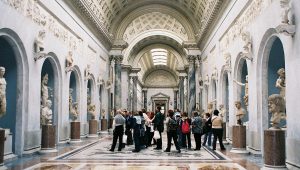Continuing Education Students Visit the Vatican Restoration Laboratory
The students of the Continuing Education course in “Management and Digitization of Cultural Heritage” visited the Painting and Wood Material Restoration Laboratory of the Vatican Museums on Thursday, November 9. Giulia Ghia, CEO at Verderame Progetto Cultura and Continuing Education Professor, organized the visit to give students a concrete perspective on the job of a restorer.
The Painting and Wood Material Restoration Laboratory of the Vatican Museums is one of its biggest and oldest, dating back to 1932. In it, specialists take care of the conservation, restoration and protection of wooden and painted works of art, both inside the Museums and in the Vatican State. The reasons why a work of art should undergo the lab intervention can be various: conservation, study, restoration, or to be prepared for exhibitions. These activities can be financed either by the Vatican Museums themselves or by patrons, committees of private citizens that decide to “adopt” a work of art and donate for its restoration.
In the laboratory, restorations follow a specific procedure. The Chief Restorer assigns one or more projects to each restorer, who has to research the work of art and plan the intervention. A team of restorers then meets and the person responsible for the project has to share his/her analysis of the work and of previous restorations. Everything said during the meeting is documented in a report, and, once the project has a clear scope, the restoration starts. As the process continues, more meetings will follow to discuss the problems encountered and the results obtained.
It is essential for future cultural managers and curators to be aware of the material aspects of artworks as well as the conditions in which they should be preserved. Good practices of conservation and restoration are crucial for the well-being of the cultural heritage and of the hosting institutions.






